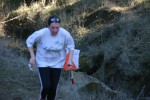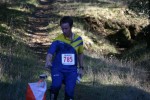Taking Accurate Compass Bearings
by
My biggest weakness as an orienteer, by far, is taking accurate compass bearings through thick, featureless forest. Unfortunately that isn't a skill we get the opportunity to practice a whole lot in the Bay Area. Much of our terrain consists of easy-to-read reentrant and spur features, and accurate compass work is not needed to navigate on such maps. In fact, I can think of several BAOC events in the last few years where people forgot their compass, ran the course without one, and didn't have a single problem.
This past summer, though, I ran on several maps where accurate compass work was essential to even complete the course. In particular, at the Western Canadian Championships in Alberta there were several completely flat areas of fairly dense, featureless forest, and to find your way from control to control, accurate compass bearings of 150 meters or more were essential. Burton Creek was like this to some extent (although that map had more recognizable detail between controls, so it was easier to readjust your bearing along the way), and the advanced courses at Big Basin this September required very accurate compass work most of the way as well (which is why it took me over three hours to complete the Blue course).
So I've been trying to learn how to get better at taking precision bearings, and have learned a couple of things which I will share below.
Hold your compass completely flat and keep it straight out in front of you. I've found that if you tilt your compass up toward you to look at it, the needle can stick a bit and throw your bearing off. Also, it's easier to see exactly where the direction arrow is pointing if you have the compass right in front of your face, rather than off to one side or the other.
In theory, taking precision bearings is an easy process. You just set the compass, pick some object in the distance that the direction arrow is pointing toward, and run to that object. Then repeat those steps as often as necessary. In dense forest, however, the trees in the distance will all appear identical, and when you look down and veer off to the side to avoid obstacles, you won't know precisely where to go when you look back up again. So it's important to alternate directions when you have to deviate from the straight-line path. If you do this, hopefully the corrections you make will cancel each other out and you will end up on your desired bearing. I discovered this summer that I am definitely "left-footed." That is, my natural tendency is to ALWAYS veer left to avoid obstacles, and as a result I am often WAY off to the left at the end of a long bearing. Now that I am aware of this, I am trying to force myself to go right half the time, but it's hard!
Of course, the best solution to the problem is to not have to rely on such accurate compass work in the first place! Given the choice between taking an accurate 150+ meter bearing straight to a control, or going out of the way somewhat to get to a closer attack point, I'll run the extra distance every time. But sometimes there's no choice - you just have to follow your compass and hope for the best. Good luck!
[Back to Training]


